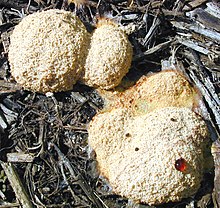| Slime molds | |
|---|---|

| |
| Aethalium of a slime mold (Fuligo septica) | |
| Scientific classification | |
| Domain: | |
| Kingdom: | |
| Phylum: | Mycetozoa
|
| Classes and orders | |
| |
Mycetozoa is a phylum of slime molds The Myxogastria, Protosteli, and Dictyosteliida make up the modern phylum . The mycetozoan groups all fit into the unikont supergroup Amoebozoa, whereas the other slime molds fit into various bikont groups.
Utility in research edit
Dictyostelids are used as examples of cellular communication and differentiation, and may provide insights into how multicellular organisms develop.
Slime molds like Physarum polycephalum are useful for studying cytoplasmic streaming. They have also been used to study the biochemical events that surround mitosis, since all the nuclei in a medium-sized plasmodium divide in synchrony. It has been observed that they can find their way through mazes by spreading out and choosing the shortest path, an interesting example of information processing without a nervous system. Myxomycete plasmodia have also been used to study the genetics of asexual cell fusion. The giant size of the plasmodial cells allows for easy evaluation of complete or partial cell fusion.
In 2006, researchers at the University of Southampton and the University of Kobe reported that they had built a six-legged robot whose movement was remotely controlled by a Physarum slime mold. The mold directed the robot into a dark corner most similar to its natural habitat.
Slime molds are sometimes studied in advanced mathematics courses. Slime mold aggregation is a natural process that can be approximated with partial differential equations.
References edit
- Sleigh, Michael. "Protozoa and Other Protists". Routledge, Chapman and Hall Inc. 1989
- Alexopolous, C.J., Charles W. Mims, M. Blackwell et al., Introductory Mycology, 4th ed. (John Wiley and Sons, Hoboken NJ, 2004) ISBN 0-471-52229-5
- Martin, G.W and C. J. Alexopoulos. 1969. "The Myxomycota" Iowa University Press.
- Ling, H. 1968. "Light and Fruiting in Didymium iridis" Mycologia Vol. pp 966-970.
- Ling, H. 1999. "Myxomycetes, Commonly Overlooked Plants" The Native Plant Society of NJ Newsletter, Fall p5.
- Alexopolous, C.J. 1962, second edition. "Introductory Mycology" John Wiley and Sons, p. 78.
- Lister,A. 1925. "A Monograph of the Mycetozoa" Johnson Reprint Corp. NY.
- Raper, K.B. (1984) The Dictyostelids. Princeton University Press.
- Karling, J.S. (1968) The Plasmodiophorales. Hafner Publishing Co.
- Bill Bryson's "A Short History of Nearly Everything".
- Nick Arnold's "Nasty Nature" (a volume in the "Horrible Science" series).
External links edit
- Slime Molds
- Slime Mould Solves Maze Puzzle from abc.net.au
- Hunting Slime Molds from Smithsonian Magazine
- "Robot Piloted by a Slime Mold". Slashdot. 2006. Retrieved February 15, 2006.
- dictyBase is an online informatics resource for Dictyostelium, a cellular slime mould.
- nomen.eumycetozoa.com is an online nomenclatural information system of slime moulds (Myxomycetes, Dictyostelids and Protostelids) of the world.
- good photo gallery
- [1]
- Slime Mold Photos Life cycle of Reticularia lycoperdon at MushooMania.com.